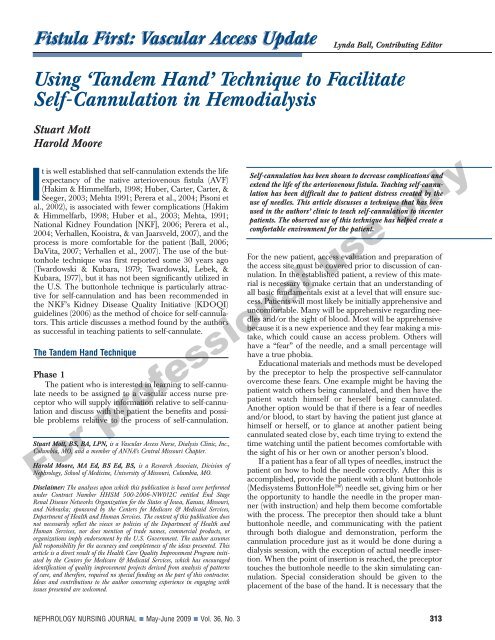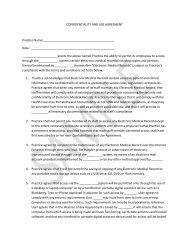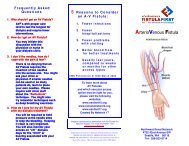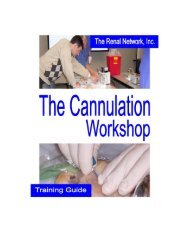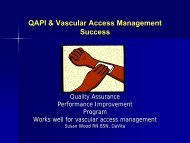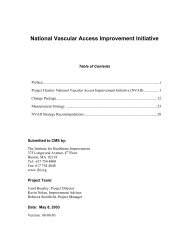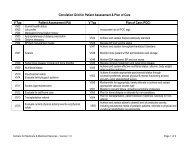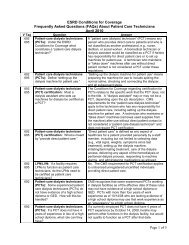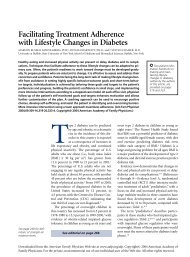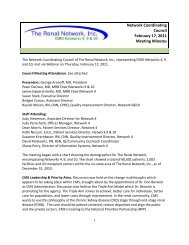Tandem Hand Technique for Self-Cannulation - Fistula First
Tandem Hand Technique for Self-Cannulation - Fistula First
Tandem Hand Technique for Self-Cannulation - Fistula First
- No tags were found...
You also want an ePaper? Increase the reach of your titles
YUMPU automatically turns print PDFs into web optimized ePapers that Google loves.
<strong>Fistula</strong> <strong>First</strong>: Vascular Access UpdateLynda Ball, Contributing EditorUsing ‘<strong>Tandem</strong> <strong>Hand</strong>’ <strong>Technique</strong> to Facilitate<strong>Self</strong>-<strong>Cannulation</strong> in HemodialysisStuart MottHarold MooreIt is well established that self-cannulation extends the lifeexpectancy of the native arteriovenous fistula (AVF)(Hakim & Himmelfarb, 1998; Huber, Carter, Carter, &Seeger, 2003; Mehta 1991; Perera et al., 2004; Pisoni etal., 2002), is associated with fewer complications (Hakim& Himmelfarb, 1998; Huber et al., 2003; Mehta, 1991;National Kidney Foundation [NKF], 2006; Perera et al.,2004; Verhallen, Kooistra, & van Jaarsveld, 2007), and theprocess is more com<strong>for</strong>table <strong>for</strong> the patient (Ball, 2006;DaVita, 2007; Verhallen et al., 2007). The use of the buttonholetechnique was first reported some 30 years ago(Twardowski & Kubara, 1979; Twardowski, Lebek, &Kubara, 1977), but it has not been significantly utilized inthe U.S. The buttonhole technique is particularly attractive<strong>for</strong> self-cannulation and has been recommended inthe NKF’s Kidney Disease Quality Initiative (KDOQI)guidelines (2006) as the method of choice <strong>for</strong> self-cannulators.This article discusses a method found by the authorsas successful in teaching patients to self-cannulate.The <strong>Tandem</strong> <strong>Hand</strong> <strong>Technique</strong>Phase 1The patient who is interested in learning to self-cannulateneeds to be assigned to a vascular access nurse preceptorwho will supply in<strong>for</strong>mation relative to self-cannulationand discuss with the patient the benefits and possibleproblems relative to the process of self-cannulation.Stuart Mott, BS, BA, LPN, is a Vascular Access Nurse, Dialysis Clinic, Inc.,Columbia, MO, and a member of ANNA’s Central Missouri Chapter.Harold Moore, MA Ed, BS Ed, BS, is a Research Associate, Division ofNephrology, School of Medicine, University of Missouri, Columbia, MO.Disclaimer: The analyses upon which this publication is based were per<strong>for</strong>medunder Contract Number HHSM 500-2006-NW012C entitled End StageRenal Disease Networks Organization <strong>for</strong> the States of Iowa, Kansas, Missouri,and Nebraska; sponsored by the Centers <strong>for</strong> Medicare & Medicaid Services,Department of Health and Human Services. The content of this publication doesnot necessarily reflect the views or policies of the Department of Health andHuman Services, nor does mention of trade names, commercial products, ororganizations imply endorsement by the U.S. Government. The author assumesfull responsibility <strong>for</strong> the accuracy and completeness of the ideas presented. Thisarticle is a direct result of the Health Care Quality Improvement Program initiatedby the Centers <strong>for</strong> Medicare & Medicaid Services, which has encouragedidentification of quality improvement projects derived from analysis of patternsof care, and there<strong>for</strong>e, required no special funding on the part of this contractor.Ideas and contributions to the author concerning experience in engaging withissues presented are welcomed.<strong>Self</strong>-cannulation has been shown to decrease complications andextend the life of the arteriovenous fistula. Teaching self-cannulationhas been difficult due to patient distress created by theuse of needles. This article discusses a technique that has beenused in the authors’ clinic to teach self-cannulation to incenterpatients. The observed use of this technique has helped create acom<strong>for</strong>table environment <strong>for</strong> the patient.For the new patient, access evaluation and preparation ofthe access site must be covered prior to discussion of cannulation.In the established patient, a review of this materialis necessary to make certain that an understanding ofall basic fundamentals exist at a level that will ensure success.Patients will most likely be initially apprehensive anduncom<strong>for</strong>table. Many will be apprehensive regarding needlesand/or the sight of blood. Most will be apprehensivebecause it is a new experience and they fear making a mistake,which could cause an access problem. Others willhave a “fear” of the needle, and a small percentage willhave a true phobia.Educational materials and methods must be developedby the preceptor to help the prospective self-cannulatorovercome these fears. One example might be having thepatient watch others being cannulated, and then have thepatient watch himself or herself being cannulated.Another option would be that if there is a fear of needlesand/or blood, to start by having the patient just glance athimself or herself, or to glance at another patient beingcannulated seated close by, each time trying to extend thetime watching until the patient becomes com<strong>for</strong>table withthe sight of his or her own or another person’s blood.If a patient has a fear of all types of needles, instruct thepatient on how to hold the needle correctly. After this isaccomplished, provide the patient with a blunt buttonhole(Medisystems ButtonHole) needle set, giving him or herthe opportunity to handle the needle in the proper manner(with instruction) and help them become com<strong>for</strong>tablewith the process. The preceptor then should take a bluntbuttonhole needle, and communicating with the patientthrough both dialogue and demonstration, per<strong>for</strong>m thecannulation procedure just as it would be done during adialysis session, with the exception of actual needle insertion.When the point of insertion is reached, the preceptortouches the buttonhole needle to the skin simulating cannulation.Special consideration should be given to theplacement of the base of the hand. It is necessary that theFor professional use onlyNEPHROLOGY NURSING JOURNAL May-June 2009 Vol. 36, No. 3 313
Using ‘<strong>Tandem</strong> <strong>Hand</strong>’ <strong>Technique</strong> to Facilitate <strong>Self</strong>-<strong>Cannulation</strong> in HemodialysisFigure 1Cocking of the Fingers Prior to <strong>Cannulation</strong>Figure 2<strong>Cannulation</strong> with Patient <strong>Tandem</strong> toVascular Access Nursehand be immobilized by anchoring the heel of the handon the arm so that with the fingers cocked, the needle tipas at the insertion site (see Figure 1) just prior to cannulation.Only the index finger and thumb move to effect cannulation.This accomplishes two important things: 1) thesolid base provides control, and 2) it helps maintain thesame angle of insertion <strong>for</strong> each cannulation, which is vitalin the use of the buttonhole technique.The nurse preceptor then provides the patient with abuttonhole needle and has the patient go through thecomplete cannulation procedure, culminating in thepatient “cannulating” his or her arm by touching it withthe needle tip. Again, this helps the patient become com<strong>for</strong>tablewith the procedure, the manipulation of the needle,and the feel of the needle touching the skin. Thisprocess is repeated until the preceptor and the patientboth feel com<strong>for</strong>table that the goals have been met <strong>for</strong> thisphase, and then move on to the next phase. The patientshould be provided with the materials (such as site preparation,blunt needles) to continue to practice this processat home several times a day to acquire the “feel” of theprocess.Phase 2Pre-cannulation preparation is carried out followingthe clinic’s prescribed protocol as practiced in Phase 1. Itis critical that the patient has had the proper educationwith demonstrated proficiency in access assessment anddisinfection of the access site prior to initiating the selfcannulationprocess. Once the pre-cannulation protocol iscompleted to the satisfaction of the preceptor, the cannulationprocess begins with the patient placing his or herthumb and <strong>for</strong>efinger just behind the thumb and <strong>for</strong>efingerfingernail of the preceptor (see Figure 2 – notice cockingof fingers). Some patients even feel the “pop” as theneedle enters the fistula. This provides a greater understandingand appreciation of the preceptor’s explanationsand instructions in relation to what the patient is feelingand how it all relates to successful cannulation.The patient is required to verbalize seeing the flashback,as he or she is in the best position to see it. This alsorein<strong>for</strong>ces the concepts of taking an active role and dialogbetween patient and caregiver. The patient can also communicateto the preceptor what he or she feels, such aspain, which may sometimes be lessened with a minoradjustment of the needle angle. This process is repeatedwith the second needle. The process should be followed<strong>for</strong> a minimum of three dialysis sessions be<strong>for</strong>e switchingto the next phase. Depending upon the patient’s and preceptor’sevaluations, the process will either be continuedor the next phase will be initiated. If there is still a modicumof apprehension, it would be most prudent to continuePhase 2 until both the patient and preceptor are com<strong>for</strong>tableand then move on to Phase 3.Phase 3The roles are now reversed. The patient handles theneedle with the preceptor placing his thumb and <strong>for</strong>efingerbehind the thumb and <strong>for</strong>efinger fingernail of thepatient (see Figure 3). This not only gives the patient afeeling of security, but the preceptor can feel what is happeningand can verbally guide the patient, and if necessary,the preceptor can very gently guide the patient’shand. This prevents the sense of failure the patient mighthave if the preceptor stopped and took over the cannulation.At the same time, it allows the preceptor the opportunityto prevent any potential complication. This processis repeated until the patient and preceptor are both com<strong>for</strong>tablewith the patient’s cannulation skill and believe thepatient is competent to continue unaided. At such time,the patient is then ready to move on to the final phase oflearning self-cannulation.For professional use only314NEPHROLOGY NURSING JOURNAL May-June 2009 Vol. 36, No. 3
Using ‘<strong>Tandem</strong> <strong>Hand</strong>’ <strong>Technique</strong> to Facilitate <strong>Self</strong>-<strong>Cannulation</strong> in Hemodialysispatients become adept in the art of self-cannulation. Itmust be emphasized that trust and communicationbetween the patient and the preceptor has to be at a highlyfunctional level be<strong>for</strong>e the process is initiated. It is thepreceptor’s responsibility to make sure that communicationis not only established, but is of this quality in orderto insure success. It is also mandatory that the patientdemonstrates his or her understanding of the process andis sufficiently knowledgeable of the responsibilities andpitfalls of self-cannulation. This is critical <strong>for</strong> the success ofany self-care process.In the authors’ center, a cannulation method, referredto as the touch cannulation technique, is taught (Mott &Prowant, 2008). With this method, the nurse cannulatorholds the needle by the tubing approximately one-quarterto one-half inch behind the wings with the thumb and<strong>for</strong>efinger directed back towards the palm. The cannulatorthen rests the palm of his or her hand on the patient’s arm,which serves as a solid fixed base, at a position that putsthe needle tip in line with the site so that only advancingthe needle is required. The needle is then advancedthrough the tissue into the fistula or graft by pushing <strong>for</strong>wardwith only the thumb and <strong>for</strong>efinger. It must beemphasized that when advancing the needle, only the<strong>for</strong>efinger and thumb move <strong>for</strong>ward. By keeping the palmfirmly seated and motionless on the patient’s arm, it ismuch easier to maintain the proper angle of insertion.It must be noted that in the case of needle apprehension,the preceptor must determine if he or she is dealingwith the “fear” of needles or if the patient is truly needlephobic. True needle phobia is found in 3% to 4% of theU.S. population (Bienvenu & Eaton, 1998; Kleinknecht,1987) and presents a diphasic cardiac response of initialtachycardia followed by bradycardia along with hypotension,shock, vertigo, diaphoresis, nausea, and though rare,asystole and death (Ellinwood & Hamilton, 1991; Marks,1988). If a patient presents with a true needle phobia, itmay require some intense psychotherapy, but it can beovercome fairly rapidly (Fernandes, 2003). The vasovagalresponse and bradycardia make true needle phobia lessresponsive to the usual relaxation techniques or even tosedative use that are commonly employed.With the provision of constructive cognitive instruction,the patient feels more at ease with the process, thus lesseningthe apprehension, which in turn leads to the developmentof a “com<strong>for</strong>t zone” <strong>for</strong> the patient and a willingnessto try self-cannulation. This com<strong>for</strong>t zone is further extendedwhen the patient has the preceptor’s thumb and fingerbehind their fingernails in the third phase. This provides asense of security <strong>for</strong> the patient that he or she will not makea mistake that could harm the fistula because the vascularaccess nurse still is involved. The authors believe the judicioususe of this method can help patients with fear of cannulation,in addition to allowing patients who are willing toself-cannulate become proficient very quickly. The authorsalso believe patients gain a sense of control over their owncare, which leads to a better overall quality of life Ball,2005; Harper, 1997; Konner, 2005; Renal PhysiciansAssociation (RPA)/American Society of Nephrology(ASN) & American Nephrology Nurses’ Association(ANNA), 2008; Verhallen et al., 2007).Implications <strong>for</strong> the Nephrology NurseThis technique is one more tool in the toolbox of vascularaccess nurses, which when combined with goodpatient education, can help reduce complications of andextend fistula life. The key is to create a com<strong>for</strong>table environment<strong>for</strong> the learner, which helps to overcome the fearof needles, of learning something new, and of making amistake that could potentially damage the access. With thepatient’s hand on the preceptor’s, he or she can “get a feel”<strong>for</strong> the cannulation process. This also takes the patient’sfocus off the pain involved and places it upon the task.This replacement of focus has been shown to create theimpression of less pain.SummaryUse of good educational techniques is a must. Theexperience of the authors has been that it takes very littletime to have patients cannulating on their own using thismethod if good techniques are used. Since it is well establishedthat self-cannulation and the buttonhole techniqueboth extend the life of the native fistula, this training techniquemakes attaining the goal of self-cannulation easier.Since there are fewer problems associated with self-cannulation,increasing its use will also, undoubtedly, have apositive monetary effect <strong>for</strong> the clinic due to fewer hospitalvisits, required procedures, and increased longevity ofaccesses.ReferencesBall, L.K. (2005). Improving arteriovenous fistula cannulationskills. Nephrology Nursing Journal, 32(6), 611-617.Ball, L.K. (2006). The buttonhole technique <strong>for</strong> arteriovenous fistulacannulation. Nephrology Nursing Journal, 33(3), 299-304.Bienvenu, O.J., & Eaton, W.W. (1998). The epidemiology ofblood-injection-injury phobia. Psychological Medicine, 28(5),1129-1136.DaVita. (2007). Rope ladder and constant site or buttonhole techniques– <strong>Cannulation</strong> methods <strong>for</strong> hemodialysis patients with a fistula.Retrieved May 9, 2009, from www.davita.com/dialysis/treatment/a/1332Ellinwood, E.H., & Hamilton, J.G. (1991). Case report of a needlephobia. Journal of Family Practice, 32(4), 420-422.Fernandes, P.P. (2003). Rapid desensitization <strong>for</strong> needle phobia.Psychosomatics, 44(3), 253-254.Hakim, R., & Himmelfarb, J. (1998). Hemodialysis access failure:A call to action. Kidney International, 54(4), 1029-1040.Harper, G. (1997). The buttonhole technique of fistula access: Apersonal experience. Home Hemodialysis International, 1, 41-42.For professional use onlycontinued on page 325316NEPHROLOGY NURSING JOURNAL May-June 2009 Vol. 36, No. 3
Using ‘<strong>Tandem</strong> <strong>Hand</strong>’ <strong>Technique</strong>continued from page 316Huber, T.S., Carter, J.W., Carter, R.L., & Seeger, J.M. (2003).Patency of autogenous and polytetrafluoroethylene upperextremity arteriovenous hemodialysis accesses: A systematicreview. Journal of Vascular Surgery, 38(5), 1005-1011.Kleinknecht, R.A. (1987). Vasovagal syncope and blood/injuryfear. Behaviour Research and Therapy, 25(3), 175-178.Konner, K. (2005). History of vascular access <strong>for</strong> hemodialysis.Nephrology Dialysis and Transplant, 20(12), 2629-2635.Marks, I. (1988). Blood-injury phobia: A review. American Journalof Psychiatry, 145(10), 1207-1213.Mehta, S. (1991). Statistical summary of clinical results of vascularaccess procedures <strong>for</strong> hemodialysis. In B. Sommer & M.Henry (Eds.), Vascular access <strong>for</strong> hemodialysis – II (pp. 145-157).Chicago: Precept Press.Mott, S., & Prowant, B.F. (2008). The “touch cannulation” technique<strong>for</strong> hemodialysis. Nephrology Nursing Journal, 35(1), 65-66.National Kidney Foundation (NKF). (2006). KDOQI clinicalpractice guidelines and clinical practice recommendations<strong>for</strong> 2006 Updates: Hemodialysis adequacy, peritoneal dialysisadequacy and vascular access. American Journal of KidneyDiseases, 48(Suppl 1), S1-S322.Perera, G.B., Mueller, M.P., Kubaska, S.M., Wilson, S.E.,Lawrence, P.F., & Fujitani, R.M. (2004). Superiority of autogenousarteriovenous hemodialysis access: Maintenance offunction with fewer secondary interventions. Annals ofVascular Surgery, 18(1), 66-73.Pisoni, R.L., Young, E.W., Dykstra, D.M., Greenwood, R.N.,Hecking, E., Gillespie, B., et al. (2002). Vascular access usein Europe and the United States: Results from DOPPS.Kidney International, 61(1), 305-316.Renal Physicians Association (RPA)/American Society ofNephrology (ASN), & American Nephrology Nurses’Association (ANNA). (2008). Joint position paper on collaborationbetween nephrologists and advanced practice nurses.Nephrology Nursing Journal, 35(3), 314.Twardowski, Z.J., & Kubara, H. (1979). Different sites vs. constantsites of needle insertion into arteriovenous fistulas <strong>for</strong>treatment by repeated dialysis. Dialysis and Transplantation,8(10), 978-980.Twardowski, Z.J., Lebek, R., & Kubara, H. (1977). Szecioletniekliniczne dowiadczenie z wytwarzaniem lo uytkowaniemwewnetrznych przetok tetniczo-ylnych u chorych leczonychpowtarzanymi hemodializami (Six-year experience with thecreation and use of internal arteriovenous fistulae in patientstreated with repeated hemodialysis) (Polish). Polish Archivesof Internal Medicine, 57(3), 205-214.Verhallen, A.M., Kooistra, M.P., & van Jaarsveld, B.C. (2007).Cannulating in hemodialysis: Rope-ladder or buttonholetechnique? Nephrology Dialysis Transplantation, 22(9), 2601-2604.For professional use onlyReprinted from the Nephrology Nursing Journal, 2009, Volume 36, Number 3, pp. 313-316,325. Reprinted with permission of the publisher, the American Nephrology Nurses'Association (ANNA); East Holly Avenue, Box 56, Pitman, NJ 08071-0056; (856)256-2300;FAX (856)589-7463; E-mail: anna@ajj.com; Web site: www.annanurse.org For a samplecopy of the journal, please contact the publisher.NEPHROLOGY NURSING JOURNAL May-June 2009 Vol. 36, No. 3 325


